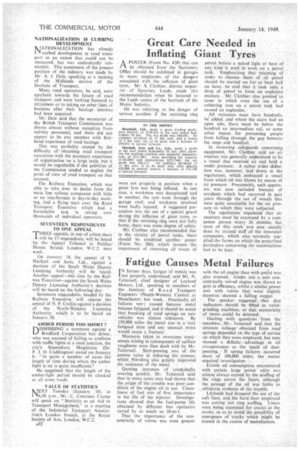Great Care Needed in Inflating Giant Tyres
Page 34

If you've noticed an error in this article please click here to report it so we can fix it.
APOSTER (Form No. 428) that can be obtained from the Stationery Office should be exhibited in garages to warn employees of the dangers associated with the inflation of giant tyres. Mr S. Clothier, district inspectorof factories, 'Leeds, made this recommendation when he lectured to the Leeds centre of the Institute of the Mothr Industry,
He Was referring, to the danger of serious accident if the retaining ring were not properly in position when a giant lyre was being inflated. In one case, a workman was decapitated and in another, the tyre went through the garage root', and workmen involved were badly injured. A suggested precaution was the use of a special guard during the inflation of giant tyres. so that if the retaining ring were not fully home, there was some degree of safety.
Mr. Clothier also recommended that in the vicinity of petrol tanks, there should be exhibited another poster (Form No. 386), which stresses the importance of removing all traces of petrol before a naked light or heat of any kind is used in work on a petrol tank. Emphasizing that steaming of tanks to cleanse them of all petrol should be carried on for at least half an hour, he said that it took only a drop of petrol to form an explosive mixture. Mr. Clothier also pointed to cases in which even the use of a soldering iron on a petrol tank had caused an explosion.• All staircases must have handrails, he' added, and where the stairs had an open side, there must be below the handrail an intermediate rail, or some other means for preventing people from falling through the gap between the steps and handrail.
In reviewing safeguards concerning equipment, Mr. Clothier said an air receiver was generally understood to be a vessel that received air and held it under pressure. A rather wider definition was, however, laid down in the regulations, which embraced a vessel from which oil was blown by means of air pressure. Presumably, such apparatus was now included because of accidents which had occurred in past years through the use of vessels that were quite unsuitable for the air pressure to which they were subjected.
The regulations stipulated that air receivers must be examined by a competent person every 26 tnonths; but most of this work was now usually done by trained staff of the insurance companies, which also normally supplied the forms on which the prescribed particulars concerning the examinations had to be kept.




























































































